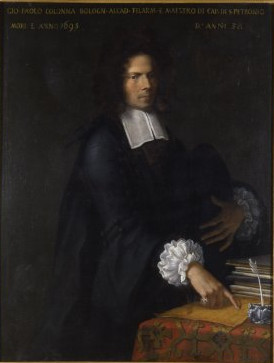Giovanni Paolo Colonna facts for kids
Giovanni Paolo Colonna (born June 16, 1637 – died November 28, 1695) was a talented Italian musician. He was a composer, a teacher, an organ player, and even an organ builder. Colonna worked as the main music director, called a chapel-master, and organist at the important San Petronio Basilica in Bologna. He also created music for powerful families in cities like Ferrara, Parma, Modena, and Florence. He helped start the Accademia Filarmonica di Bologna, a famous music academy, and later became its president. Even Emperor Leopold I of Austria collected his church music. Colonna's music was similar to the style of Giacomo Carissimi and even hinted at the music of George Frideric Handel.
Contents
The Life of Giovanni Paolo Colonna
Giovanni Paolo Colonna was born on June 16, 1637, in Bologna, Italy. At that time, Bologna was the second-largest city in the Papal States, after Rome. He was one of five children. His father, Antonio Colonna, was a well-known organ builder. The Colonna family had been building organs in Italy for a long time.
Early Training and Career
Giovanni Paolo learned both how to build organs and how to play music. He studied music in Bologna and later in Rome. In Rome, he even worked as an organist at a church called S. Apollinare. People started noticing his skills as a composer around 1659. That same year, he became an organist at the San Petronio Basilica in Bologna. By November 1, 1674, he was promoted to the main music director, or chapel-master, there.
Working with Important People
From 1680 to 1694, Colonna often wrote letters to Francesco II d'Este, Duke of Modena. He composed oratorios (large musical stories, usually religious) for the Duke and helped build organs for him. Other important people who supported his music included the Marquis of Ferrara, Ranuccio II Farnese, Duke of Parma, and the powerful Medici family in Florence. For them, he wrote secular cantatas (shorter vocal pieces).
Music Academy and Later Years
In 1666, Colonna was one of the first people to join the Accademia Filarmonica in Bologna. This was a very important music school. He was the president of the academy for many years, from 1672 to 1691. In 1694, he traveled to Rome. He had been part of a disagreement about how Arcangelo Corelli used certain musical notes, called parallel fifths. While in Rome, Pope Innocent XII offered him a job as the chapel-master of St. Peter's Basilica. But Colonna turned down the offer, possibly because he was not feeling well. He passed away in Bologna in 1695.
Some of Colonna's students became famous musicians themselves. These included the cellist and composer Giovanni Bononcini and his brother Antonio Maria Bononcini.
Giovanni Paolo Colonna's Music
Most of Colonna's music was written for the church. This included settings of psalms (religious songs) for different numbers of voices. He also composed various masses and motets (short religious choral pieces). He wrote one opera called Amilcare. He was also a very important composer of oratorios. Eight of his oratorios are still known today, including La Profezia d'Eliseo.
His Style and Influence
Emperor Leopold I of Austria received a copy of every sacred piece Colonna composed. Today, the Austrian National Library has 83 of these works. Colonna's music was written to sound great in the large San Petronio Basilica. Many of his pieces for two choirs used two separate continuo parts. These parts were played on the church's two organs.
Colonna's music style was generally serious and grand. He lived during a time when church music was changing. He was able to combine the serious feel of older music with the bright, new sounds of his time. In some of his later works, he created complex and beautiful effects. He did this by skillfully using melodies and harmony.
His Messe e salmi concertati op.10 (Masses and Psalms) had separate parts for string instruments. These parts included fast musical runs, like in the early concerto style. Some of his motets were written in a lively, melodic style. This style was similar to the Roman church cantatas of Giacomo Carissimi. It even hinted at the chamber cantatas that Handel would later compose.


